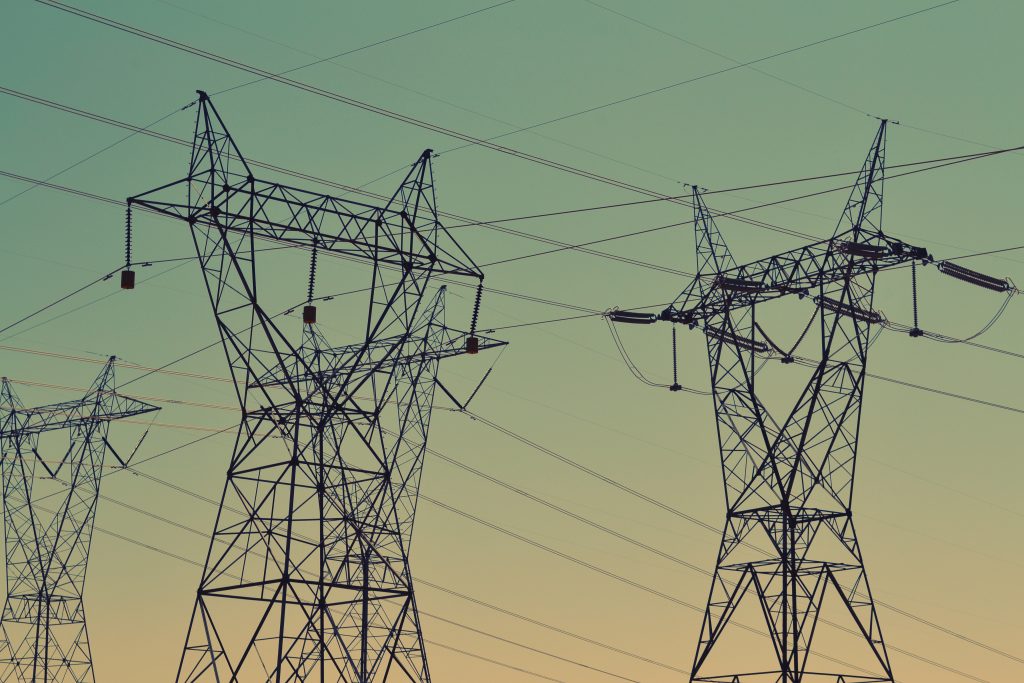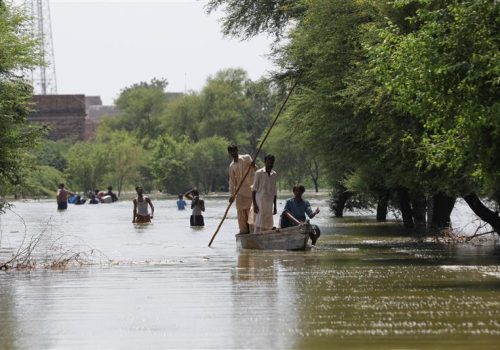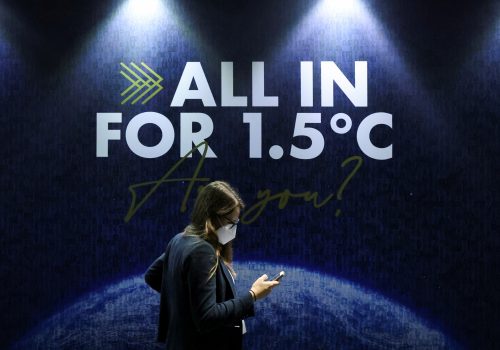The March 20, 2023 summit meeting in Moscow between Chinese President Xi Jinping and Russian President Vladimir Putin, combined with the coinciding remarks of United Nations (UN) Secretary General António Guterres for a “G20 Climate Solidarity Pact,” provide important context for considering the role of South Asia and its energy position and prospects.
The countries of South Asia are caught in the geopolitics of “great power competition,” with India, Pakistan, Bangladesh, and Sri Lanka all abstaining on the February UN resolution condemning Russia’s invasion of Ukraine. They are also on the front lines of the climate crisis and are experiencing severe impacts from floods, droughts, and heat while continuing to grow their carbon dioxide emissions. As a low per capita income region, South Asia demands increasing energy supplies to foster economic growth for its large and growing population, which is approaching two billion people.
In its efforts to meet these needs, the region faces the triple challenges of energy security, energy equity, and environmental sustainability, termed the “energy trilemma” by the World Energy Council. This blog provides an overview of the difficult and complex situation faced by countries in the region and the market and geopolitical factors influencing developments there. It concludes that while countries are taking positive steps in the transition to a sustainable energy mix, they face the risk of backsliding in their policies and investment efforts.
While countries in Africa and Southeast Asia are entering into Just Energy Transition Partnerships with Western and international organizations, South Asian countries are instead being subjected to the consequences of China and Russia’s efforts to expand their political and economic influence in the region. In this complex geopolitical context, expanded US and G7 clean energy efforts are needed.
The state of play
Energy security
Energy security is an important concern since South Asia—a major importer of oil, gas, and coal—has become more dependent on the volatile global energy market in recent years. The region consumed about 7 percent of world primary energy in 2021, with about 85 percent of this in India. Growth in energy consumption since 2011 has averaged about 4 percent per annum.
India is the third largest global importer of crude oil and products with over 82 percent of its consumption imported. Liquefied natural gas (LNG) imports constitute about 45 percent of Indian domestic gas consumption, with the US providing about 17 percent of these imports. With the cut-offs of oil and gas exports to Europe after the invasion of Ukraine and ensuing sanctions packages, Russia has been desperate to find outlets for its oil, and India has used the opportunity to buy discounted Russian oil well below the $60 G7 cap price, saving last year by one estimate $3.6 billion in import costs. Reported crude oil imports from Russia in December 2022 were one million barrels per day or about 25 percent of India’s normal imports.
Pakistan and Bangladesh are looking at importing discounted Russian crude oil and refined products after March 2023, but it is not clear whether the discounts will match those of India. High LNG prices and lower demand resulted in decreased LNG imports by both (six and fifteen million tons reduction respectively in 2022 compared with 2021) as LNG suppliers were focused on replacing Russian gas in Europe. With China’s economic recovery spurring a rebound in LNG imports, Europe’s continuing efforts to diversify gas supplies and refill stocks, and no new major supply coming online until 2026 due to lead times in new liquefaction capacity projects (especially in Qatar and the United States, although the Freeport LNG facility in Texas recently returned to full production capacity after an explosion last summer), the prospects are for a tight LNG market in the next few years.
Although Bangladesh is moving to resume LNG imports with the recent easing of spot prices, it hopes to reduce natural gas imports and convert its regasification plants to handle green hydrogen by 2030. Pakistan is reconsidering its position on new gas power plants and further imports of LNG. India, however, seems to be continuing with plans to increase the role of gas in its energy mix with regasification capacity expected to increase from the current forty-two million tons to seventy million in 2030.
In the face of growing energy demand, increasing imports, and geopolitical and energy security concerns, South Asian countries need to ramp up their domestic clean energy development to limit import dependency, reduce poverty, and improve environmental performance.
Energy equity
Over seventy-seven million South Asians lack electricity. India, Bangladesh, Nepal, and Sri Lanka have all made major progress since 2010, connecting almost 350 million people. However, World Bank data suggests that Pakistan has made little progress in reducing its unserved population of around fifty-four million.
This problem stems from many factors, including the lack of a focused government effort, the financially weak position of Pakistan’s electricity distribution companies, devastating floods and glacial melt that have destroyed electricity infrastructure, widespread corruption, and the remote location and security issues of villages in the north and west. Proposals have been offered to create a Rural Electrification Board, as in Bangladesh, to spearhead a serious program to reach off-grid villages and introduce solar household and mini-grid systems. Yet progress remains slow.
In addition to conventional grid extension and the US Agency for International Development (USAID) and World Bank-supported system of rural electric cooperatives, Bangladesh also has pioneered a rural solar energy program. It is being carried out by the quasi-governmental Infrastructure Development Company Limited in cooperation with non-governmental organizations and local companies and with support from the World Bank, USAID, and other donors. This effort has helped to deploy over six million solar home and microgrid systems to over twenty million people. The World Bank believes it is the largest-off grid program in the world.
The Indian government also funds rural solar deployment, but private companies have increased their presence in this area. Notably, the Tata conglomerate has established a subsidiary, TP Renewable Microgrid, dedicated to microgrid development. They have installed 161 microgrids in their start-up phase and aim to deploy ten thousand.
Through its roll out of innovative business models and technology, the private sector has an important role to play when it comes to access and equity in the power sector, building on and stop-gaping government policies.
Environmental sustainability
The environment in South Asia is under tremendous pressure from industrial development, urbanization, population growth, and climate change. With the region accounting for about 8.6 percent of global energy-related carbon dioxide emissions in 2021, international attention has focused on the future of coal. India is the second-largest global coal consumer and where coal in 2021 accounted for 57 percent of primary energy and 71 percent of electricity generation. Although the Indian government is making progress on an ambitious diversification program, including five hundred gigawatts (GW) of renewables by 2030, the government does not envision the country reaching net-zero emissions until 2070. Further, the Central Electricity Authority’s plans call for twenty-five GW of new coal-fired capacity by 2027.
In Pakistan and Bangladesh, after building several coal plants with Chinese, Japanese, and Korean financing, the governments adopted coal moratoriums in 2021 and were on a path to substitute LNG, renewables, and nuclear for coal; however, energy security and price factors led Bangladesh in September 2022 to announce plans to add 4.3 GW of coal-fired capacity, and in February 2023, Pakistani Federal Minister for Energy Khurram Dastgir Khan reversed policy and called for ten GW of domestically-fired coal plants over the next decade. Whether these coal plant additions can be financed given these countries’ serious debt problems and the announced policies of China, Japan, and South Korea to stop financing overseas coal plants remains to be seen.
Despite these policy shifts, Pakistan continues to pursue the former Imran Khan government’s target of 60 percent hydro and renewable energy by 2030, while Bangladesh aims to reach 4.1 GW of renewables by 2030 and 40 percent clean energy (renewable, hydro, and nuclear) by 2041. The smaller countries of the region have set more ambitious targets. Nepal, with its large hydro capacity, has advanced its net-zero target to 2045 and Sri Lanka, despite its current dependence on oil and coal for two-thirds of electricity generation, embraced a 2050 target with 70 percent renewables by 2030.
The pursuit of nuclear power is a small but significant dimension of the energy transition plans in India, Pakistan, and Bangladesh, and these countries have turned to China and Russia for technology and financing. As part of an overall push to export its indigenous technology, China has supplied and brought online two Hualong One reactors in Karachi under a $6 billion loan. As part of its $120 billion global nuclear export program, Russia has provided two VVER-413 reactors which went into operation in 2013 and 2016 at Kudankulam and is working with India on four additional one thousand MW reactors. Russia loaned Bangladesh over $11 billion for two VVER-1200 V-523 units which are under construction at Rooppur and are expected to be completed by 2024 and 2025.
Protecting the region’s environment is critical for its human security; but cost and political interference make the line of equilibrium between clean and affordable energy hard to find—let alone to walk—for the countries of South Asia.
What should be done
In conclusion, global energy security and climate change issues will continue to play out in South Asia with Russia and China expanding their influence through oil, renewable, and nuclear technology exports and project financing.
As South Asian countries navigate the geopolitics of energy and address their energy trilemma challenge, it is critical that the United States, its allies, and companies expand their cooperation and energy investment in the region. The fall G20 meeting in India will be an opportunity to highlight Western intentions and offer concrete initiatives, such as when Japanese Prime Minister Fumio Kishida pledged $75 billion in regional investment for infrastructure and security as part of the “free and open Indo-Pacific” initiative during his recent visit to India.
As in the Indonesia Just Energy Transition Partnership agreement (co-led by the United States and Japan), Washington should partner with Japan and G7 allies on an expanded clean energy transition initiative in South Asia, with a possible endorsement at the G7 meeting hosted by Japan in May. Building on the US interagency Clean EDGE Asia Initiative and the five-year, $49 million USAID South Asia Regional Energy Partnership program, such an initiative might give special focus to the modernization and strengthening of the electricity transmission and distribution systems in the region. The goal should be to enhance reliability and resilience, improve financial viability, reduce technical and commercial losses, and increase system capacity to integrate the higher levels of intermittent renewables that the countries are aspiring to achieve.
The energy trilemma will represent a fundamental challenge to South Asia’s sustainable development for years to come. Strong government commitments, creative thinking and technology innovation, multilateral partnerships, increased Western support, and public-private collaboration can help this booming, emerging-market region power its people and industries in an efficient and affordable manner while also limiting damage to the environment and contributing to progress on global climate.
Dr. Robert F. Ichord, Jr. is a nonresident senior fellow at the Atlantic Council Global Energy Center.

The South Asia Center is the hub for the Atlantic Council’s analysis of the political, social, geographical, and cultural diversity of the region. At the intersection of South Asia and its geopolitics, SAC cultivates dialogue to shape policy and forge ties between the region and the global community.

The Global Energy Center develops and promotes pragmatic and nonpartisan policy solutions designed to advance global energy security, enhance economic opportunity, and accelerate pathways to net-zero emissions.
Related content
Image: Electrical towers and power lines against a sky at sunset (photo by Fré Sonneveld on Unsplash).



